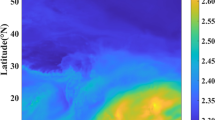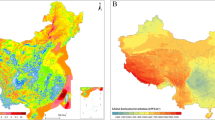Abstract
Multiple disasters such as strong wind and torrential rain pose great threats to civil infrastructures. However, most existing studies ignored the dependence structure between them, as well as the effect of wind direction. From the dimension of the engineering sector, this paper introduces the vine copula to model the joint probability distribution (JPD) of wind speed, wind direction and rain intensity based on the field data in Yangjiang, China during 1971–2020. First, the profiles of wind and rain in the studied area are statistically analyzed, and the original rainfall amounts are converted into short-term rain intensity. Then, the marginal distributions of individual variables and their pairwise dependence structures are built, followed by the development of the trivariate joint distribution model. The results show that the constructed vine copula-based model can well characterize the dependence structure between wind speed, wind direction and rain intensity. Meanwhile, the JPD characteristics of wind speed and rain intensity show significant variations depending on wind direction, thus the effect of wind direction cannot be neglected. The proposed JPD model will be conducive for reasonable and precise performance assessment of structures subjected to multiple hazards of wind and rain actions.
Similar content being viewed by others
References
Hines E, Reid C E. Hurricane Harvey hospital flood impacts: Accuracy of federal emergency management agency flood hazard areas in Harris County, Texas. Am J Public Health, 2020, 110: 574–579
Zhang X, Chen G, Cai L, et al. Impact assessments of Typhoon Lekima on forest damages in subtropical China using machine learning methods and Landsat 8 OLI imagery. Sustainability, 2021, 13: 4893
Tsimplis M N. The correlation of wind speed and rain. Weather, 1994, 49: 135–139
Li Z N, Luo D F, Shi W H, et al. Field measurement of wind-induced stress on glass facade of a coastal high-rise building. Sci China Tech Sci, 2011, 54: 2587–2596
Hu S Y, Wang Z Z, Wang Y T, et al. Encounter probability analysis of typhoon and plum rain in the Taihu Lake Basin. Sci China Tech Sci, 2010, 53: 3331–3340
Ke S, Yu W, Wang T, et al. Aerodynamic performance and wind-induced effect of large-scale wind turbine system under yaw and windrain combination action. Renew Energy, 2019, 136: 235–253
Chang Y, Zhao L, Ge Y. Theoretical and testing investigation of wind-rain coupling loads on some typical bluff bodies. Adv Struct Eng, 2019, 22: 156–171
Tian L, Zeng Y J, Fu X. Velocity ratio of wind-driven rain and its application on a transmission tower subjected to wind and rain loads. J Perform Constr Facil, 2018, 32: 04018065
Li H N, Tang S Y, Yi T H. Wind-rain-induced vibration test and analytical method of high-voltage transmission tower. Struct Eng Mech, 2013, 48: 435–453
Xin D B, Li H, Ou J P, et al. Experimental study on flutter stability of a long-span bridge subject to wind-rain actions. Sci China Tech Sci, 2013, 56: 2089–2098
Lan M, Shao Y, Zhu J, et al. A hybrid copula-fragility approach for investigating the impact of hazard dependence on a process facility’s failure. Process Saf Environ Prot, 2021, 149: 1017–1030
Ye Y, Fang W. Estimation of the compound hazard severity of tropical cyclones over coastal China during 1949–2011 with copula function. Nat Hazards, 2018, 93: 887–903
Gou H Y, Leng D, Wang H Y, et al. Joint probability distribution model of wind velocity and rainfall with mixed copula function (in Chinese). China J Highw Transp, 2021, 34: 309–316
Blocken B, Carmeliet J. Guidelines for the required time resolution of meteorological input data for wind-driven rain calculations on buildings. J Wind Eng Ind Aerodyn, 2008, 96: 621–639
Isyumov N, Ho E, Case P. Influence of wind directionality on wind loads and responses. J Wind Eng Ind Aerodyn, 2014, 133: 169–180
Ierimonti L, Caracoglia L, Venanzi I, et al. Investigation on life-cycle damage cost of wind-excited tall buildings considering directionality effects. J Wind Eng Ind Aerodyn, 2017, 171: 207–218
Simiu E, Heckert N A. Ultimate wind loads and direction effects in non-hurricane and hurricane-prone regions. Environmetrics, 1998, 9: 433–444
Krishnasamy S G, Ramani N. Wind direction and extreme wind loads for overhead power line design. In: Probablistic Methods Applied to Electric Power Systems. Proceedings of the First International Symposium. 1987. 399–412
Wang X Y, Jiang Q C, Sun H X, et al. Joint probability distribution model of wind-rain-induced vibration parameters of stay cables on cable-stayed bridges (in Chinese). China J Civ Eng, 2017, 50: 69–74
Yu K, Zhang X, Li P, et al. Probability prediction of peak break-up water level through vine copulas. Hydrol Process, 2019, 33: 962–977
Vernieuwe H, Vandenberghe S, De Baets B, et al. A continuous rainfall model based on vine copulas. Hydrol Earth Syst Sci, 2015, 19: 2685–2699
Ni L, Wang D, Wu J, et al. Vine copula selection using mutual information for hydrological dependence modeling. Environ Res, 2020, 186: 109604
Fang C, Xu Y L, Li Y. Optimized C-vine copula and environmental contour of joint wind-wave environment for sea-crossing bridges. J Wind Eng Ind Aerodyn, 2022, 225: 104989
Heredia-Zavoni E, Montes-Iturrizaga R. Modeling directional environmental contours using three dimensional vine copulas. Ocean Eng, 2019, 187: 106102
Montes-Iturrizaga R, Heredia-Zavoni E. Multivariate environmental contours using C-vine copulas. Ocean Eng, 2016, 118: 68–82
Wang Z, Zhang W, Zhang Y, et al. Circular-linear-linear probabilistic model based on vine copulas: An application to the joint distribution of wind direction, wind speed, and air temperature. J Wind Eng Ind Aerodyn, 2021, 215: 104704
Chen Q, Yu C, Li Y. General strategies for modeling joint probability density function of wind speed, wind direction and wind attack angle. J Wind Eng Ind Aerodyn, 2022, 225: 104985
Zhang W, Wang Z, Liu Z. Joint distribution of wind speed, wind direction, and air temperature actions on long-span bridges derived via trivariate metaelliptical and Plackett copulas. J Bridge Eng, 2020, 25: 04020069
Aas K, Czado C, Frigessi A, et al. Pair-copula constructions of multiple dependence. Insur Math Econo, 2009, 44: 182–198
Bedford T, Cooke R M. Probability density decomposition for conditionally dependent random variables modeled by vines. Ann Math Artif Intel, 2001, 32: 245–268
Nelsen R B. An Introduction to Copulas. New York: Springer New York, 2000
Tao Y, Wang Y, Wang D, et al. A C-vine copula framework to predict daily water temperature in the Yangtze River. J Hydrol, 2021, 598: 126430
Pérez-Bella J M, Domínguez-Hernández J, Martínez-Martínez J E, et al. An alternative approach to estimate any subdaily extreme of rainfall and wind from usually available records. Stoch Environ Res Risk Assess, 2022, 36: 1819–1833
Kikuchi N, Matsuzaki Y, Yukino T, et al. Aerodynamic drag of new-design electric power wire in a heavy rainfall and wind. J Wind Eng Ind Aerodyn, 2003, 91: 41–51
Coles S. An Introduction to Statistical Modeling of Extreme Values. New York: Springer, 2001. 221
Moran P A P. Statistical inference with bivariate gamma distributions. Biometrika, 1969, 56: 627
Carta J A, Ramírez P, Velázquez S. A review of wind speed probability distributions used in wind energy analysis. Renew Sustain Energy Rev, 2009, 13: 933–955
Erdem E, Shi J. Comparison of bivariate distribution construction approaches for analysing wind speed and direction data. Wind Energ, 2011, 14: 27–41
Genest C, Rivest L P. Statistical inference procedures for bivariate archimedean copulas. J Am Statistical Assoc, 1993, 88: 1034–1043
Sancetta A, Satchell S. The Bernstein copula and its applications to modeling and approximations of multivariate distributions. Econ Theor, 2004, 20: 535–562
Soukissian T H. Probabilistic modeling of directional and linear characteristics of wind and sea states. Ocean Eng, 2014, 91: 91–110
Akaike H. A new look at the statistical model identification. IEEE Trans Automat Contr, 1974, 19: 716–723
Author information
Authors and Affiliations
Corresponding authors
Additional information
The authors acknowledge the China Meteorological Administration for providing the recorded wind and rain data. This work was supported by the National Natural Science Foundation of China (Grant Nos. 52178489 and 52078106) and the Young Scholars Program of Shandong University (Grant No. 2017WLJH33.
Supporting Information
The supporting information is available online at https://tech.scichina.com and https://link.springer.com. The supporting materials are published as submitted, without typesetting or editing. The responsibility for scientific accuracy and content remains entirely with the authors.
Rights and permissions
About this article
Cite this article
Bi, W., Tian, L., Li, C. et al. Multi-hazard joint probability distribution model for wind speed, wind direction and rain intensity. Sci. China Technol. Sci. 66, 336–345 (2023). https://doi.org/10.1007/s11431-022-2210-3
Received:
Accepted:
Published:
Issue Date:
DOI: https://doi.org/10.1007/s11431-022-2210-3




